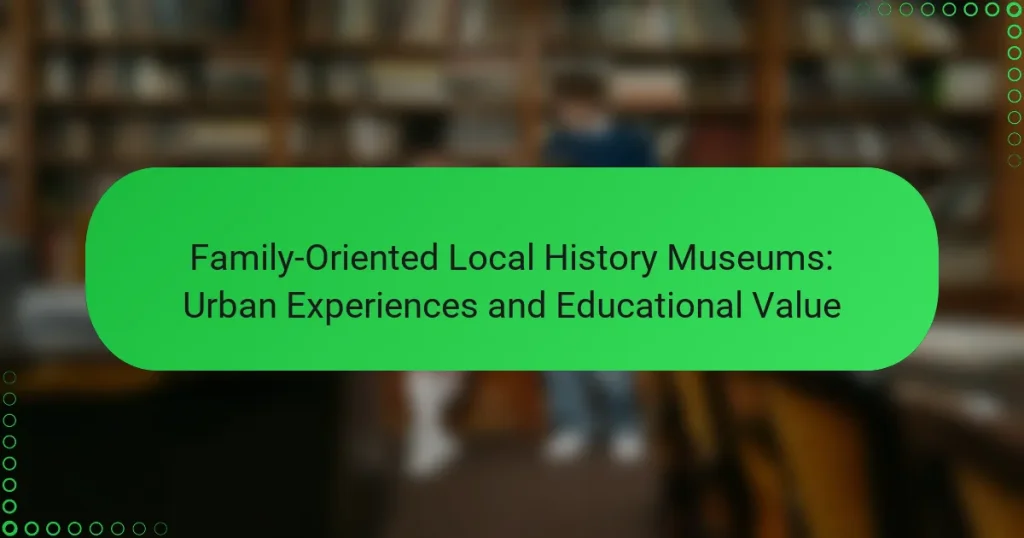Family-oriented local history museums play a vital role in urban environments by offering interactive and engaging educational experiences for visitors of all ages. These institutions not only connect communities with their past but also enhance cultural understanding through hands-on exhibits and diverse programs. By immersing visitors in local history, these museums foster a sense of belonging and appreciation for the unique narratives that shape their surroundings.
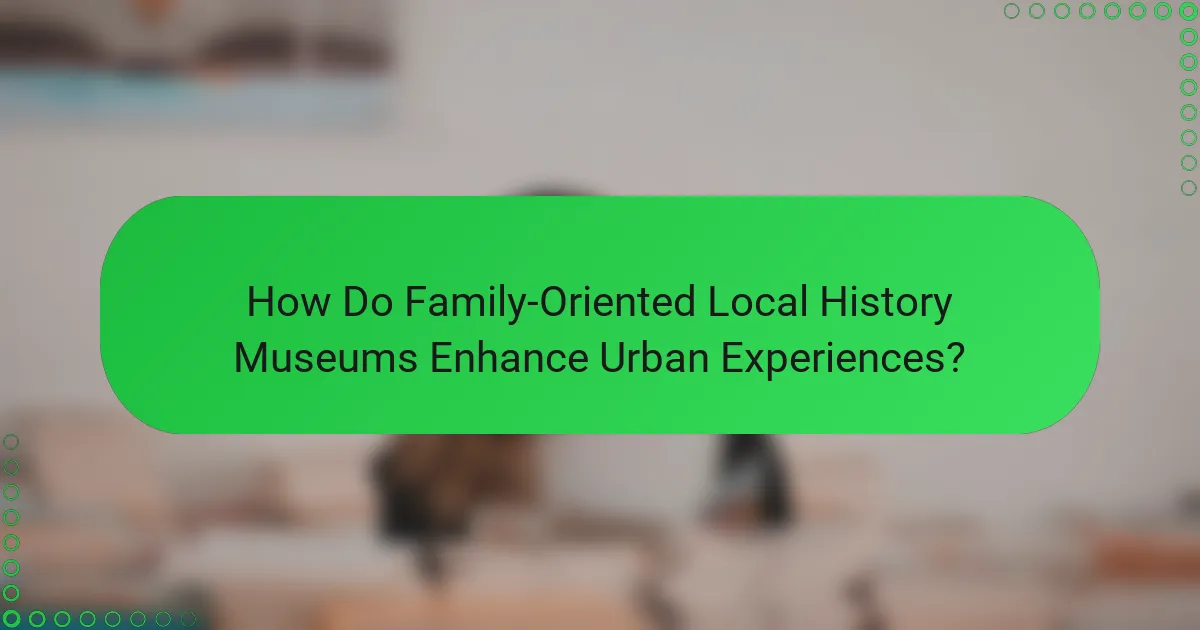
How Do Family-Oriented Local History Museums Enhance Urban Experiences?
Family-oriented local history museums enrich urban experiences by providing interactive learning opportunities that engage visitors of all ages. These museums foster community connections and enhance cultural understanding through hands-on exhibits and educational programs.
Interactive exhibits
Interactive exhibits are designed to engage visitors actively, allowing families to explore history through touch and participation. For example, many museums feature replicas of historical artifacts that children can handle or digital displays that encourage learning through games.
These exhibits often incorporate technology, such as augmented reality, to bring historical events to life, making the experience more immersive. Families can expect to spend anywhere from one to three hours exploring these engaging installations, depending on their interests.
Community engagement programs
Community engagement programs are essential for fostering connections between the museum and local residents. These programs may include family days, where families can participate in themed activities, or collaborative events with local schools that promote history education.
Such initiatives not only enhance the museum’s role as a community hub but also encourage families to share their own stories and histories, creating a richer narrative tapestry. Participation in these programs can increase community pride and awareness of local heritage.
Workshops and educational activities
Workshops and educational activities provide hands-on learning experiences that cater to various age groups. These may include crafting sessions, historical reenactments, or guided tours that delve deeper into specific topics of interest.
Families can benefit from these activities by gaining practical skills and knowledge about their local history. Many museums offer workshops at low or no cost, making them accessible to a wide audience and encouraging regular participation.

What Educational Value Do Local History Museums Provide?
Local history museums offer significant educational value by providing immersive experiences that connect visitors with their community’s past. They serve as resources for learning about historical events, cultural heritage, and the evolution of local societies.
Curriculum-aligned programs
Many local history museums develop programs that align with educational curricula, making them valuable resources for schools. These programs often include guided tours, workshops, and interactive exhibits designed to meet specific learning objectives.
For example, a museum might offer a program focused on the industrial revolution, where students can explore artifacts and engage in discussions that complement their classroom learning. Teachers can easily integrate these experiences into their lesson plans, enhancing students’ understanding of history.
Hands-on learning opportunities
Hands-on learning is a hallmark of local history museums, allowing visitors to engage directly with artifacts and exhibits. This approach fosters a deeper understanding of historical contexts and encourages critical thinking.
Activities such as artifact handling, reenactments, and craft workshops enable families to experience history in a tangible way. For instance, a museum might host a day where families can participate in traditional crafts, providing a practical connection to the past.
Historical storytelling techniques
Local history museums often employ storytelling techniques to convey historical narratives effectively. By using engaging narratives, they bring history to life, making it relatable and memorable for visitors of all ages.
Techniques may include guided storytelling sessions, multimedia presentations, and interactive displays that encourage visitors to explore different perspectives. This approach not only captivates audiences but also helps them understand the complexities of historical events and their relevance today.
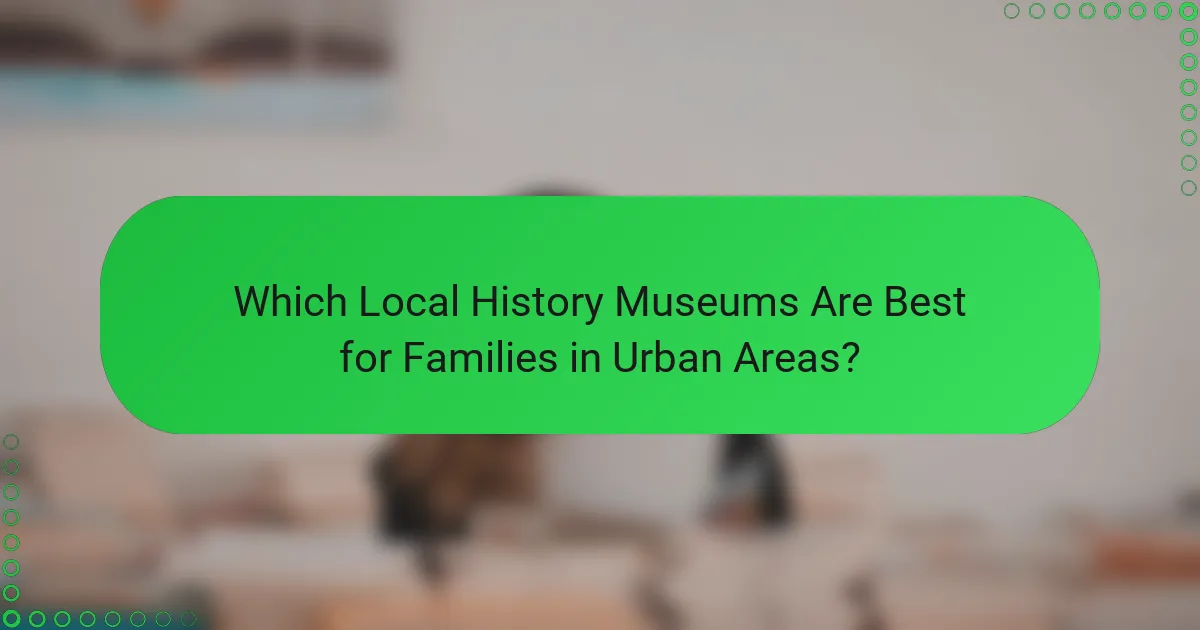
Which Local History Museums Are Best for Families in Urban Areas?
Family-oriented local history museums in urban areas provide engaging educational experiences that cater to all ages. These museums often feature interactive exhibits, workshops, and programs designed to make history accessible and enjoyable for children and adults alike.
Chicago History Museum
The Chicago History Museum offers a rich exploration of the city’s past through engaging exhibits and family-friendly activities. Visitors can enjoy hands-on experiences, such as the “Chicago: Crossroads of America” exhibit, which showcases the city’s diverse history.
Families should consider visiting during special events like “Family Days,” where children can participate in crafts and storytelling sessions. Admission prices are reasonable, often around $15 for adults, with discounts for children and families.
New York Historical Society
The New York Historical Society is a fantastic destination for families, featuring a wide array of exhibits that highlight the city’s history. The museum includes a dedicated children’s museum, where kids can engage in interactive learning experiences tailored to their age group.
Families can take advantage of free admission on certain days, making it an affordable option for exploring New York’s rich heritage. Look out for family workshops that encourage creativity and critical thinking through history-themed activities.
Los Angeles County Museum of Art
While primarily an art museum, the Los Angeles County Museum of Art (LACMA) integrates local history into its exhibits, offering programs that connect art with the cultural history of Los Angeles. Families can explore various art forms and their historical contexts through guided tours and interactive installations.
Admission is typically around $25 for adults, with free entry for children under 18, making it a budget-friendly option for families. Check the museum’s calendar for family-friendly events and workshops that enhance the educational experience.
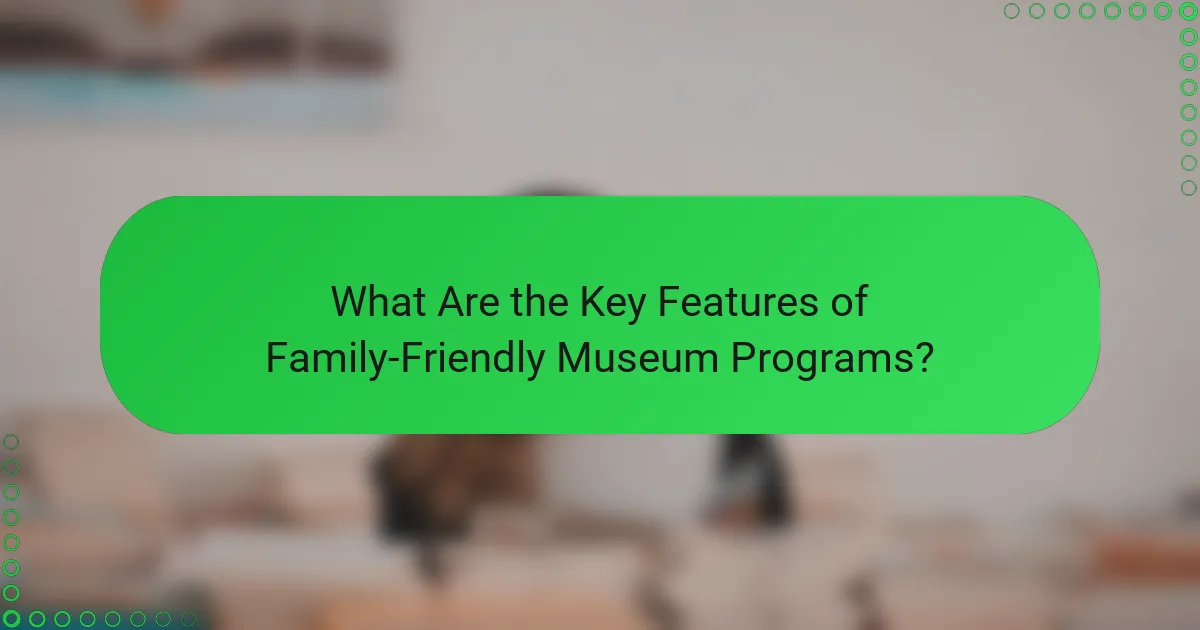
What Are the Key Features of Family-Friendly Museum Programs?
Family-friendly museum programs are designed to engage visitors of all ages through interactive and educational experiences. These programs typically emphasize age-appropriate activities, membership benefits, and special events that enhance the overall learning experience for families.
Age-appropriate activities
Family-oriented museums often provide a variety of age-appropriate activities that cater to different developmental stages. For younger children, hands-on exhibits and storytelling sessions can spark curiosity, while older kids may enjoy interactive workshops or guided tours that delve deeper into historical topics.
When selecting a museum, check their schedule for programs specifically designed for various age groups. Many museums offer seasonal activities or themed days that can enhance the experience, making it both fun and educational.
Family membership benefits
Joining a family membership at a local museum can offer significant advantages, including free admission for all family members, discounts on special events, and exclusive access to members-only activities. These memberships often pay for themselves after just a few visits, making them a cost-effective option for frequent visitors.
Additionally, many museums provide members with newsletters or updates about upcoming programs, ensuring families stay informed about new exhibits and events. This can help families plan their visits around special activities that align with their interests.
Special events and exhibitions
Special events and exhibitions are key features of family-friendly museum programs, often designed to attract visitors during holidays or school breaks. These events may include workshops, guest speakers, or themed festivals that provide unique learning opportunities.
To maximize your experience, check the museum’s calendar for upcoming events. Participating in these activities can enrich your understanding of the exhibits and create lasting memories for your family. Many museums also offer discounted or free admission during these special occasions, making them even more accessible.
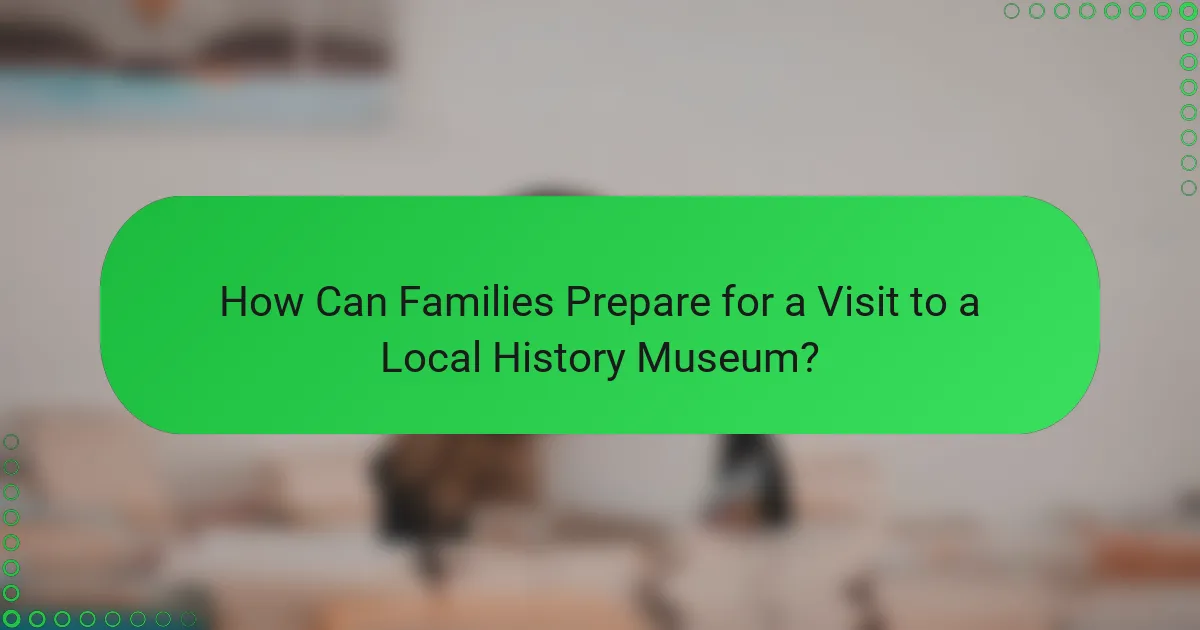
How Can Families Prepare for a Visit to a Local History Museum?
Families can prepare for a visit to a local history museum by planning ahead and utilizing available resources. This ensures a more enriching experience that caters to all ages and interests.
Advance ticket purchases
Buying tickets in advance can save time and guarantee entry, especially during peak visiting hours or special exhibitions. Many museums offer online ticketing options, which can also provide discounts compared to on-site purchases.
Consider checking if the museum has a family pass or group rates, which can be more economical for larger families. Always review the cancellation policy before purchasing, as it varies by institution.
Planning a themed visit
Creating a themed visit can enhance the educational experience for families. Choose a specific topic, such as local history, art, or science, and focus your museum exploration around that theme.
For instance, if your family is interested in the Civil War, research exhibits related to that era and plan discussions or activities that tie into what you see. This approach can make the visit more engaging and memorable for children.
Reviewing museum resources
Before your visit, review the museum’s website for resources such as maps, educational materials, and event schedules. Many museums offer downloadable guides or activity sheets designed for children, which can enhance their learning experience.
Additionally, check for any workshops, guided tours, or special programs that may be available on the day of your visit. Engaging with these resources can provide deeper insights and make the experience more interactive for the entire family.

What Criteria Should Families Consider When Choosing a Museum?
Families should consider factors such as educational value, interactive exhibits, and accessibility when selecting a museum. These criteria help ensure a meaningful and enjoyable experience for all family members.
Educational Value
When evaluating a museum’s educational value, look for exhibits that align with your family’s interests and learning goals. Museums that offer hands-on activities or guided tours can enhance understanding and retention of information.
Consider whether the museum provides programs tailored for children, such as workshops or storytelling sessions. These programs can significantly enrich the learning experience and make history more relatable.
Interactive Exhibits
Interactive exhibits engage visitors and make learning more enjoyable. Look for museums that feature touch screens, simulations, or immersive environments that encourage participation.
Hands-on activities, such as crafting or role-playing, can be particularly appealing to younger audiences. These experiences not only entertain but also foster curiosity and critical thinking skills.
Accessibility
Accessibility is crucial for families with members who have mobility challenges or special needs. Check if the museum is wheelchair-friendly and offers services like audio guides or sensory-friendly hours.
Additionally, consider the location and transportation options. A museum that is easily reachable by public transport or has ample parking can make visits more convenient for families.
Cost and Membership Options
Cost is an important factor when choosing a museum. Many local history museums offer affordable admission fees, while some may provide free entry on certain days. Look for discounts for families or group rates to save money.
Membership options can also be beneficial for frequent visitors. Annual memberships often come with perks like free admission, exclusive events, and discounts at the museum shop.
